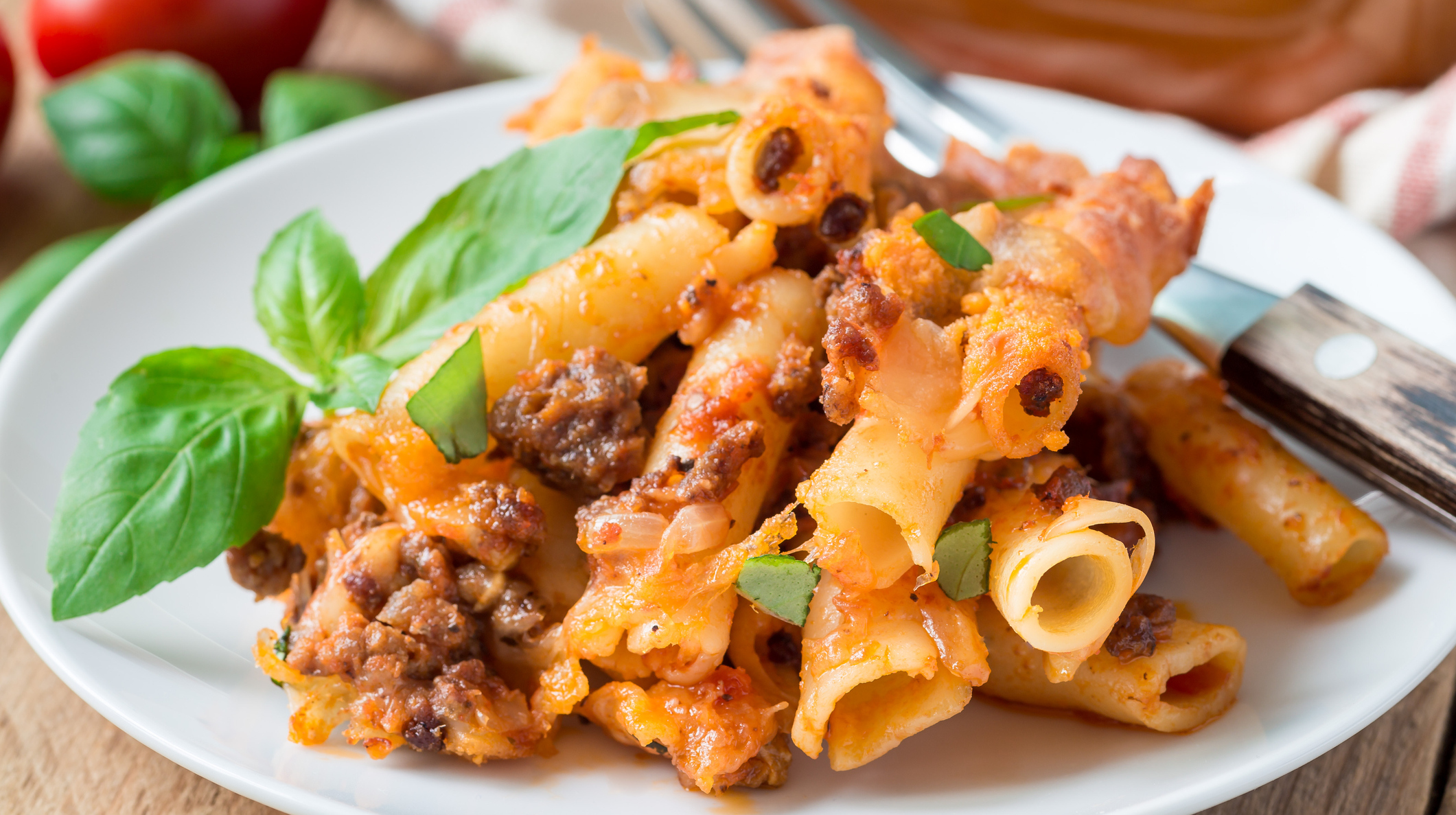Only A Real Jabroni Would Make Baked Ziti And Not Use Ziti Pasta
Thus begins my open letter to a disturbing number of pizza joints and red-sauce Italian-American restaurants: If your menu says "baked ziti," the dish had better be baked ziti. Eight out of 10 times that I order it (in my un-scientific analysis), your server delivers me a plate of baked penne. Now, I know what you're going to say I'm splitting hairs. I assure you that I am not.
I know my pasta shapes. I've been devouring virtually every geometric iteration available in the northeastern United States since the '70s. Back then, we weren't even calling it "pasta" yet: it was simply "macaroni." (Up until at least the late '80s, only cokehead elitist yuppies were calling it "pasta" in an effort to convince everyone of how worldly they were.) A ziti noodle is tubular, cylindrical in shape, sometimes with a slight curvature in its body. The ends are cut in a straight line, not on an angle like penne. The sides are typically smooth, though some versions have ridges. If they do, their box says "ziti rigati." Sometimes the box will say "cut ziti" as well, since the noodles we've grown accustomed to have been chopped down from their original 10-inch length.
Growing up, our local sports leagues, houses of worship, and schools all held ziti dinners as fundraisers. They weren't penne dinners. They weren't even spaghetti dinners. They were ziti dinners. But in the past 25 to 30 years or so, ziti's popularity started to recede and penne, for some reason, replaced it. If a trattoria or a pizzeria lists on its menu a pasta baked with mozzarella, tomato sauce, and sometimes ricotta, I'd wager my dinner on the assertion that they'd call it "ziti" and instead deliver me its pointy cousin.
Look, penne's a perfectly acceptable and serviceable option. But it's essentially the participation trophy of pasta. It's boring. If there were a perfect sauce to go with it, it'd be meh-rinara.
Ziti, on the other hand, has so much going for it. I love the way it holds the sauce, some of which finds its way into the noodle's pipe-like structure. Penne's open ends tend to be a bit too narrow for that and the sharp edges are practically stabbing the sauce away. Ziti is also far more ricotta-friendly than penne. And, debate me on this all you want, but I will die on this hill: Ziti just tastes and maintains its consistency better when re-heated after a couple of days in the fridge. Hell, it's even good cold.
The biggest feather in ziti's cap, however, is its historical role as a baking pasta. (Watch Stanley Tucci and Tony Shalhoub make the Timpano in Big Night if you don't believe me.) Ziti traditionally had served that purpose in Campania, its place of origin, where it frequently found its way on to the menu at wedding celebrations (zita derives from maccheroni della zita, "macaroni of the bride/young maiden/young girl," in the southern Italian dialect)
That's how it evolved into what we now know, in these parts, as baked ziti. Penne just doesn't have that same history in the oven that ziti has.
A recent dinner outing with my parents restored my faith, somewhat, in the macaroni-making world. Bareli's by the Sea in Spring Lake, New Jersey, offers its "Sunday Sauce And Ziti" every... well, Sunday. I was eager to order it, as I am any time I see Sunday gravy on a menu, but I was doubly so because of the type of pasta it promised—not to mention the fact that said pasta was smothered in a slow-cooked red sauce with meatballs, sausage, beef braciole, and spare ribs (and a wonderful dollop of ricotta). I didn't want to be an asshole and ask the waiter if it was really ziti. I was pleasantly surprised when it arrived and it was everything it claimed to be. To make it with any other pasta would have been a rookie mistake—just as it would if it were baked.
Yours in gluttony,Jeff
Jeff’s Baked Ziti-That’s-Really-Ziti
- 2 pounds ziti (use penne and you're dead to me)
- 1 pound ricotta cheese
- 1 1/2 pounds mozzarella, shredded or thinly sliced
- 4 Tbsp. grated Parmigiano Reggiano or Pecorino Romano
- 84 oz. tomato sauce, meat or marinara (Please don't use a jarred sauce. Now's the time to whip up a batch using your favorite recipe.)
- 1/4 cup fresh parsley, finely chopped
Preheat oven to 350 degrees Fahrenheit. On the stove, bring a large stock pot of water to a boil. When it reaches the boiling point, add six teaspoons of salt to the water. Add the ziti. Cook only for a few minutes, until it softens up, but is still a couple notches from reaching al dente. Strain into colander, recapturing some of the pasta water in a measuring cup.
In a large bowl, stir the pasta with the ricotta and parsley until the ingredients are evenly distributed across all of the noodles. Pour about a quarter of the sauce across the bottom of a large baking dish and then spread about a third of the ziti/ricotta/parsley mixture on top of the sauce. Sprinkle on a little of the pasta water, but don't drown it (repeat this step after each layer). Spread a third of the thinly sliced or shredded mozzarella across the top of that layer.
Cover that with an additional quarter of sauce. Add another third of ziti/ricotta/parsley mixture on top of that. Spread another third of mozzarella across the top of that layer. Cover with another quarter of sauce. Top with remaining ziti/ricotta/parsley mix, sauce and mozzarella, in that order.
Cover dish with foil and bake in the oven for 50 minutes to an hour. Use a meat thermometer at about the 40-minute mark to test the center and adjust cooking time accordingly. Serve, and avoid looking at a scale for several days.
